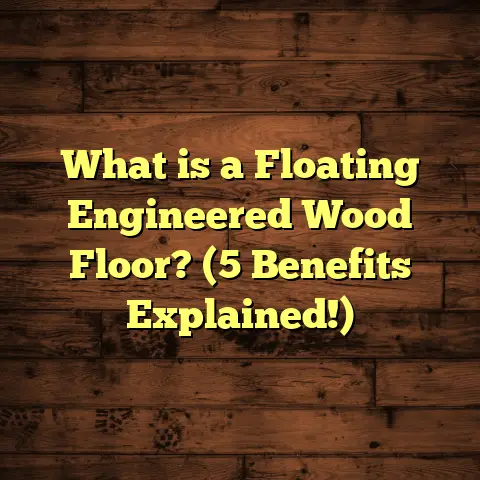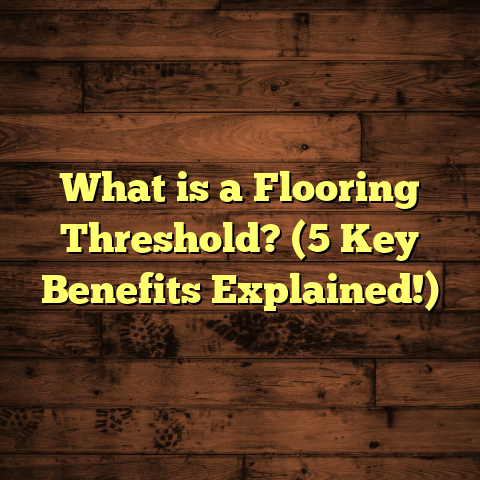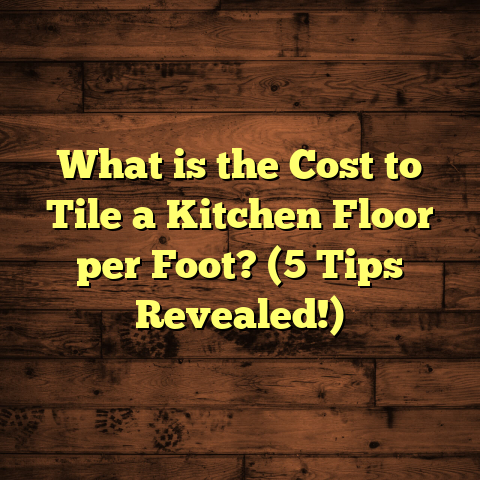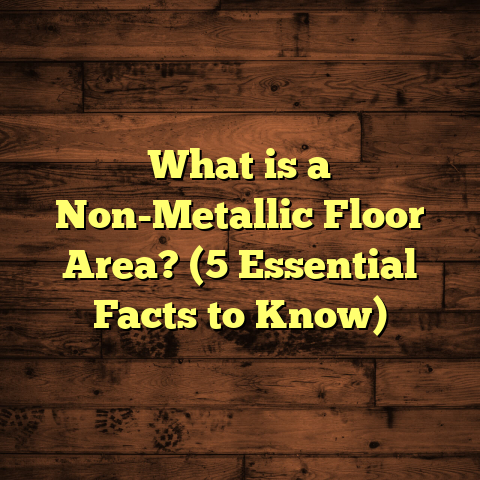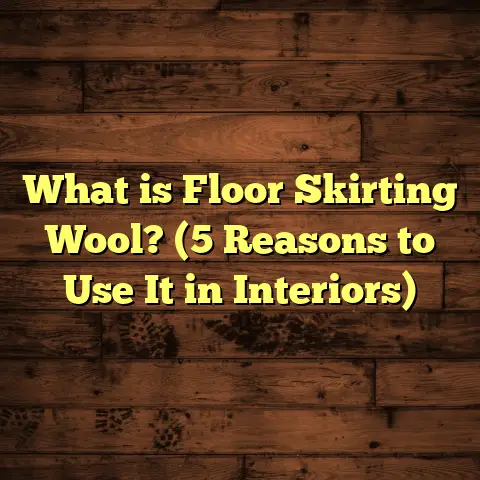What is VLT Flooring? (5 Benefits You Didn’t Know About!)
I still recall the first time I encountered VLT flooring on a project. It was a bit of a surprise—something that wasn’t quite mainstream yet but had this subtle promise of being different. I’d been working with hardwood, laminate, and traditional vinyl for years, and when a client asked me about a flooring option that combined durability with style, I started digging. That’s when I stumbled upon VLT flooring, or Vinyl Luxury Tile. Since then, I’ve used it in multiple projects—from cozy family kitchens to high-traffic commercial spaces—and each time, it’s impressed me in ways I hadn’t expected.
If you’ve been hearing about VLT flooring and wondering what it’s all about, or if you’re looking for a flooring option that offers the best of both worlds—style and strength—you’re in the right place. I’ll break down what VLT flooring really is, how it stacks up against other materials, and share five benefits you might not know about. Plus, I’ll walk you through installation tips, maintenance advice, and some real results from my own projects. So grab a cup of coffee and let’s get into it.
What Is VLT Flooring?
Alright, first things first: what exactly is VLT flooring? The term stands for Vinyl Luxury Tile. Unlike your basic vinyl sheet flooring or standard vinyl planks, VLT is designed to mimic natural materials like wood planks or stone tiles—but with a luxury twist.
It’s made up of multiple layers:
- Wear Layer: This is the top surface you walk on. For VLT flooring, this layer is usually enhanced with urethane or ceramic bead coatings that make it resistant to scratches, stains, and fading.
- Design Layer: Just beneath the wear layer is a printed design that realistically mimics wood grains, stone textures, or ceramic patterns. Thanks to advances in printing technology, these designs look incredibly authentic.
- Core Layer: This gives the tile its strength and dimensional stability. It’s often made from PVC or other resilient composites that resist dents and warping.
- Backing Layer: The bottom layer provides support and sometimes sound absorption or moisture barriers.
What makes VLT flooring stand out is the balance between luxury aesthetics and practical performance. It provides the look many homeowners crave but with the benefits of vinyl’s durability and water resistance.
From my experience, VLT flooring can be found in a variety of formats—square tiles or rectangular planks—and thicknesses usually range between 3mm to 6mm. The thicker options tend to feel more solid underfoot and offer better sound insulation.
How Does It Compare to Other Flooring Types?
You might ask: why not just go for hardwood or laminate? Or even standard vinyl plank flooring?
Hardwood is beautiful but expensive and prone to scratches and water damage. Laminate can mimic wood well but tends to swell with moisture exposure. Standard vinyl planks are affordable and water-resistant but often lack the realistic texture and luxury finish of VLT.
VLT flooring fills that sweet spot where you get:
- The look and feel of natural materials
- Superior durability and water resistance
- Easier installation with click-lock systems or glue-down options
- Low maintenance requirements
In many ways, VLT flooring bridges the gap between style and practicality better than most alternatives.
Why I Recommend VLT Flooring: Personal Experience
I’ve installed hundreds of floors over the years—everything from traditional oak hardwood to industrial-grade epoxy coatings.
When I first tested VLT flooring on a small bathroom remodel for a client with kids, I was impressed by how easily the tiles snapped into place. The texture felt surprisingly real underfoot, and the waterproof nature gave both me and my client peace of mind.
Since then, I’ve used VLT in kitchens (where spills happen daily), basements (where moisture is a constant threat), and even retail spaces with heavy foot traffic. One particular project sticks out—a family home where the kids were rough on floors and pets were part of daily life. The VLT tiles looked great after two years without a single scratch or stain.
Another memorable case was installing VLT in a basement gym. Traditional hardwood would have been a disaster there because of moisture and sweat. VLT handled it like a champ—no swelling or warping even after months of use.
Installing VLT Flooring: A Step-by-Step Guide from My Toolbox
Over the years, I’ve learned that installation quality can make or break any flooring project. With VLT flooring, getting it right is pretty straightforward if you follow some key steps:
1. Prepare Your Subfloor
A smooth, dry subfloor is critical. Whether your base is concrete, plywood, or existing flooring, you need to ensure there are no bumps or debris.
During one project in an older home, I found uneven concrete that caused small gaps after laying tiles. Grinding down the high spots solved the problem.
2. Acclimate Your Tiles
Vinyl expands and contracts slightly with temperature changes. Leaving your tiles in the room for at least 48 hours before installation helps them adjust to humidity and temperature.
This step prevents warping or gaps later on.
3. Choose Your Installation Method
Most VLT flooring comes with two main options:
- Click-Lock Installation: Tiles snap together without glue. This method is great for DIYers and allows easy removal if needed.
- Glue-Down Installation: For commercial spaces or areas exposed to moisture, glue-down ensures extra stability.
Personally, I prefer click-lock for residential spaces because it saves time and mess.
4. Use Underlayment if Needed
Depending on your subfloor type and soundproofing needs, you might add an underlayment layer.
For example, foam underlayments can reduce noise and add comfort underfoot — something clients appreciate in apartments or upstairs rooms.
5. Lay Out Tiles Strategically
Take your time planning patterns—staggered layouts or herringbone styles can add visual interest.
I always recommend dry-fitting tiles before locking them in place so you can make adjustments without hassle.
6. Cut Tiles Carefully
Use a sharp utility knife or vinyl cutter for clean edges around corners or cabinets.
Don’t rush this part—clean cuts keep your floor looking professional.
7. Finish With Baseboards or Moldings
Once tiles are installed, baseboards hide expansion gaps around walls while adding a polished look.
Caring for Your VLT Flooring: What I Tell Clients
I like to keep maintenance simple for my clients because no one wants to spend hours scrubbing floors every week.
Here are my top tips:
- Sweep or Vacuum Weekly: Dirt and grit act like sandpaper on any floor surface.
- Damp Mop as Needed: Use mild detergents made for vinyl floors.
- Avoid Excess Water: While VLT is water-resistant, standing water isn’t good for any floor.
- Furniture Pads Are Your Friends: They prevent scratching when moving chairs or tables.
- Clean Spills Quickly: Even though stains are rare on VLT tile surfaces, cleaning spills promptly keeps everything looking fresh.
One client told me she loves that she can mop her kitchen floors in under 10 minutes each week without worrying about damage—something she couldn’t say about her old hardwood floors.
5 Benefits of VLT Flooring You Didn’t Know About
Now let’s get into some benefits I’ve noticed over years of working with VLT flooring—things that often surprise people.
1. Outstanding Water Resistance That Protects Your Investment
You may already know vinyl floors handle water better than wood or laminate—but did you know that many VLT products are nearly 100% waterproof?
I’ve tested this by spilling water on floors during installations; some hardwood edges started swelling within minutes while VLT tiles stayed perfectly dry underneath.
This makes VLT ideal for:
- Bathrooms
- Basements
- Laundry rooms
- Kitchens
Where moisture is unavoidable but you still want stylish floors.
A recent industry test showed water absorption rates below 0.1% for quality VLT tiles compared to over 10% for some laminates.
2. Built-In Noise Reduction: Perfect For Busy Homes
Walking across hard floors often feels noisy—especially if you have kids running around or live above neighbors.
VLT floors have sound-dampening cores combined with optional underlayments that absorb impact noise well.
In one apartment building project I worked on in New York City, tenants reported significantly reduced footstep noise after installing VLT tiles compared to their previous laminate floors.
This benefit often goes unnoticed until people live with quiet floors—they notice how much calmer their space feels.
3. Allergy-Friendly Surface That Keeps Air Cleaner
If allergies run in your family—or if you want to create a healthier indoor environment—VLT flooring can help.
Unlike carpet that traps dust mites and allergens, VLT’s smooth surface doesn’t harbor particles.
Regular sweeping and mopping remove allergens easily instead of stirring them up into the air.
A study by a major indoor air quality institute found homes with hard surface floors had significantly fewer airborne allergens than those with wall-to-wall carpet.
4. Eco-Friendly Options That Don’t Sacrifice Quality
Sustainability matters more now than ever before. Many manufacturers have stepped up by producing VLT tiles using recycled materials or low-emission adhesives.
Look for certifications like FloorScore or GREENGUARD when shopping—that guarantees lower VOC emissions and healthier indoor air quality.
I recently installed eco-certified VLT flooring in a client’s office who prioritized green building materials—they were thrilled with both performance and environmental impact.
5. Cost Savings Over Time Thanks to Durability & Low Maintenance
At first glance, luxury vinyl might seem pricier than basic vinyl sheets or laminate—but when you factor in lifespan and upkeep costs,
VLT often comes out ahead financially.
Here’s why:
- Lifespan ranges from 15 to 20 years with proper care
- Scratch resistance can be up to 5 times higher than standard vinyl
- Little need for costly refinishing or replacement
- Cleaning requires only mild detergents
Using tools like FloorTally helps me estimate total project costs including materials, labor, waste factor (typically around 5-10%), and installation time—which ensures budgets stay realistic without surprises later on.
For example, on one recent kitchen remodel using VLT flooring:
- Material cost: $4 per sq ft
- Labor cost: $3 per sq ft
- Total installed cost: $7 per sq ft
- Compared to hardwood costing $12+ per sq ft installed
When factoring in maintenance savings over 10 years (no refinishing needed), the price difference becomes even more favorable for vinyl luxury tile.
Getting Into More Detail: The Science Behind VLT Flooring Durability
Let me geek out here for a moment because understanding why VLT flooring lasts so long helps clarify why it’s such an excellent choice.
The secret lies in its multi-layer construction:
- The wear layer contains urethane blended with ceramic beads that form a micro-hard surface resistant to abrasion.
- Beneath that is the printed design layer protected by clear films that prevent fading from UV exposure.
- The core’s PVC composite offers flexibility plus strength—unlike rigid laminates that crack under pressure.
- Finally, backing layers often include moisture barriers preventing subfloor dampness from affecting the tiles above.
These materials combined create a floor that withstands thousands of footfalls daily without showing wear—even in commercial environments.
Case Study: A Retail Store That Needed Both Style & Durability
A local boutique clothing store contacted me because their existing laminate floor was peeling and dull after just three years of heavy foot traffic.
They wanted something visually stunning but tough enough to handle daily customers plus occasional spills from drinks during events.
We decided on a stone-look VLT tile with a thick wear layer rated for commercial use (AC4 rating).
Installation took two days over their concrete slab with minimal downtime.
After six months:
- No visible wear despite steady foot traffic
- Easy cleaning after spills
- Customers complimented the modern aesthetic
The owner told me they appreciated how quickly installation went and how little upkeep was needed compared to their previous floor choice.
More Tips from My Experience With VLT Flooring
If you’re considering this type of floor for your next project, here are some additional pointers based on what I’ve learned:
- Select the Right Thickness: Thicker tiles (around 5mm+) feel sturdier and last longer but cost more upfront.
- Mind Temperature Extremes: While durable, extreme heat sources near floors can cause slight expansion—avoid placing hot appliances directly on them.
- Match Underlayment Wisely: For soundproofing or cushioning, pair your VLT flooring with compatible pads recommended by manufacturers.
- Clean With Care: Avoid oil-based cleaners as they can leave residue dulling the finish.
Frequently Asked Questions About VLT Flooring
Is VLT Flooring Suitable for Outdoor Use?
Generally no. While waterproof indoors, UV exposure outdoors can cause fading or warping over time unless specifically designed for exterior use (which is rare).
Can I Install VLT Flooring Over Existing Floors?
Often yes—as long as your current floor is flat and stable (like vinyl sheets or tile). Uneven surfaces require leveling before installation.
How Long Does Installation Take?
For an average-sized room (~200 sq ft), expect 4–6 hours with click-lock installation done by professionals; DIY might take longer depending on experience.
Is It Safe for Pets?
Absolutely! It’s scratch-resistant and easy to clean pet hair or accidents off without damage.
Wrapping Up My Thoughts on VLT Flooring
After years working closely with all types of flooring materials, I’ve come to appreciate what makes Vinyl Luxury Tile unique: it combines beauty with resilience in ways not many options do at this price point. It fits perfectly if you want stylish floors without worrying about moisture damage or constant upkeep—and it offers benefits like noise reduction and allergy-friendliness that many overlook at first glance.
If you’re weighing your choices right now, think about what matters most to you: ease of installation? Durability? Maintenance? Style? Chances are good that VLT flooring checks many of those boxes better than other options out there.
And hey—if budgeting feels tricky at any point during planning your floor update, using tools like FloorTally has helped me countless times to break down costs clearly without guessing games. It takes into account local material prices, labor rates, waste factors (usually around 5%), so you get realistic numbers upfront instead of surprises later on.
Have questions about whether VLT flooring fits your home? Or want tips on installation techniques? Just ask—I’m happy to share what I know so you get floors you’ll love walking on every day!
